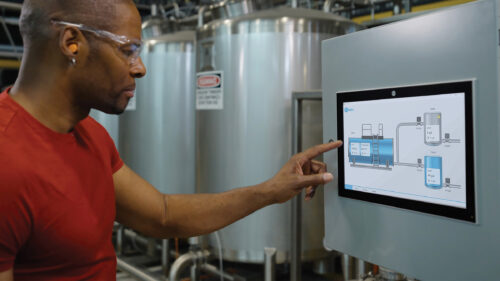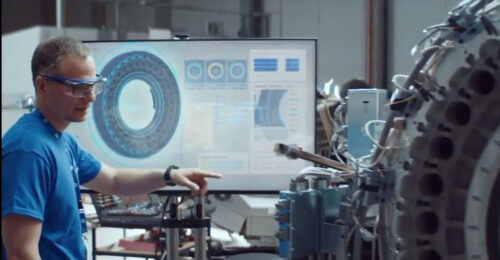Automated System Improves Catalytic Converter Production
Founded in 1865 and in the automotive exhaust business since 1931, Eberspaecher N.A. is a tier-one supplier of both catalytic converter cans and complete exhaust systems to some of the world’s most notable automotive brands including Chrysler, Dodge, Jeep, Pontiac, Buick, Chevrolet, and Mercedes-Benz.
Founded in 1865 and in the automotive exhaust business since 1931, Eberspaecher N.A. is a tier-one supplier of both catalytic converter cans and complete exhaust systems to some of the world’s most notable automotive brands including Chrysler, Dodge, Jeep, Pontiac, Buick, Chevrolet, and Mercedes-Benz. The German-based company has owned operating facilities in the USA and Canada since 2000 and currently manufactures product in Brighton, MI, as well as Tuscaloosa, AL, and Brampton, Ontario, Canada.
When the organization wanted to add a new catalytic converter production line in the Brighton facility, Eberspaecher N.A. opted for a somewhat unconventional process, selecting to install a laser-welding short-tube production cell instead of a “traditional” tube mill.
At the heart of this system is a “Twinmaster” roll-forming and laser-welding production system, supplied by Weil Engineering North America of Troy, MI. Weil Engineering, a subsidiary of Weil Engineering GmbH, Muellheim, Germany, currently has more than 60 tube forming and welding systems in operation in North America, most of them using lasers for welding application.
Complete production center
The Twinmaster combines two major functions in one machine: roll-forming and welding. Secondary processes such as blank feeding and post-welding expansion of tubes for perfect roundness are directly linked to the Twinmaster, creating one complete production center. The control functions for the entire system are supplied by Siemens, using a Sinumerik 840D for computer numerical control (CNC) and a Simatic OP170 operator panel for dialog functions. The human-machine interface (HMI) is configured by Weil Engineering in ProTool for the unique performance requirements of this production system.
The production system was designed to accommodate a wide range of product and customer demands, including:
Tube diameters of 3 in. to 8 in.;
Tube lengths of 8 in. to 50 in.;
Round or oval tube shapes;
Wall thickness of 0.020 to 0.080 in.; and
Mild and stainless steels.
Built for speed
One of the most notable aspects of the system is its ability to combine flexibility with performance, fabricating up to 500 parts per hour with a welding speed of four to five meters per minute using a 3.2 kW laser.
The system was designed from the ground-up to deliver continuous operation and rapid production. Two rotary-table mounted sheet-metal destackers are each loaded with approximately one hour’s production material and used to feed the blanks into the roll-former. Blanks are inspected for double-sheet condition during the transfer movement and, once the first destacker is empty, the rotary table moves the second destacker into place and the first one can be re-loaded. This approach ensures a non-stop supply of material.
Depending on the length of the tubes, multiple blanks (up to 4) can be rolled into tubes during the same machine cycle. The rolled tube blanks are automatically transferred from the roller to the seam welder, where they are automatically clamped and butt-welded using a Trumpf TLF 3200 laser. The Twinmaster system is also available using Tungsten inert gas (TIG) welding for this process, and Eberspaecher has one of each variation. However, while TIG offers lower initial costs, it is also yields slower welding speeds than a laser-based approach.
Once the welding process is complete, the finished cans are extracted from the tooling and transferred onto an inline weld annealing system, which heats the welding zone to approx. 1000ter substrates, the thickness of the insulation mats and the spring-back of the stainless steel material used for the converter cans.
In control
The sequences of these operations, the exact timing for each process and the control of all movements are monitored and operated by the Siemens Sinumerik 840 D controller. The Siemens CNC also monitors the position, the power and the on/off condition of the laser beam, as well as all the transfer mechanisms and the tooling. According to Weil Engineering’s service manager, Matthias Philipp, “The open architecture and substantial power of the CNC make it possible to easily monitor and control all these various functions. We also produce our own HMI protocols for the CNC and PLC on the operator panel. The Siemens system makes this much easier to accomplish.”
Onboard the Twinmaster, the Siemens CNC technology controls eight rotary axes, with the Simodrive 611U drive package on the destacker and chamfering device. Another 611U operates four axes on the expander and handling system. All CNC, PLC, HMI, and drive systems communicate via Profibus, enabling one CNC program to be written and adapted by the machine builders, such as Weil Engineering, to modify their controls based on the particular functionalities of their equipment. In this case, for example, two analog outputs are utilized for power and sequencing to control ramping, on/off and other parameters of the laser. The Trumpf laser on the Twinmaster machine has a 200 mm optics bifocal mirror with a constant focal length. When the material thickness changes, the CNC tooling varies the position of the work piece.
High-performance machine
Value of the new production system is shown in the business and productivity improvements it delivers. This metal-forming application increased catalytic converter can production by 20%, improved part quality and expedited data capture.
According to Anthony Mussarelli, Eberspaecher’s engineering manager, “These machines have made a significant improvement in our responsiveness to customer delivery requirements. The tooling sequences, the implementation of customer-driven design changes and the overall continuous production of our various end product shapes and sizes have made our satisfaction complete. The added training our people received from Weil Engineering and Siemens was an additional benefit.”
Author Information
John Meyer is manager of marketing communications at Siemens CNC and may be contacted at SiemensMTBUMarCom.sea@siemens.com .
Do you have experience and expertise with the topics mentioned in this content? You should consider contributing to our CFE Media editorial team and getting the recognition you and your company deserve. Click here to start this process.





